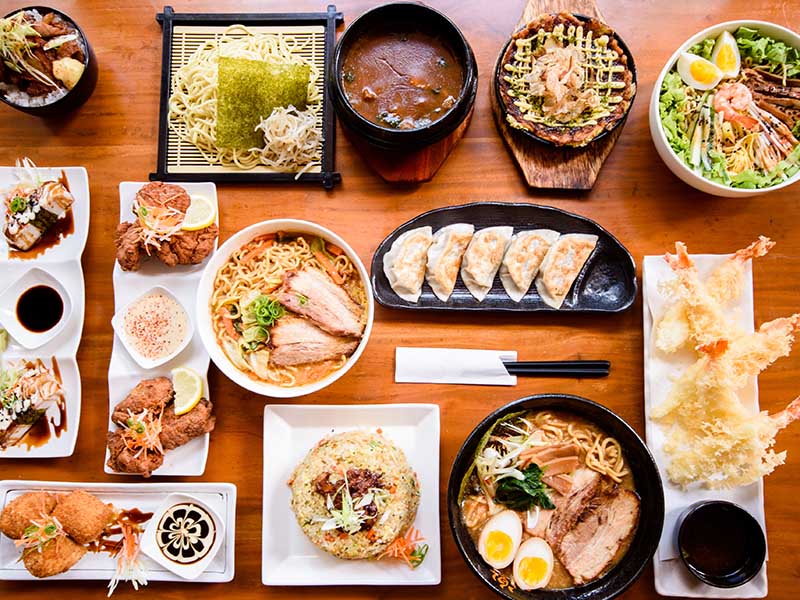Japan has contributed significantly to the culture of other Western countries over the past few decades. In addition to revolutionizing cars, computers, and cartoon characters, Japan has also introduced us to a delicious and highly unique cuisine. Outside of Japan, Japanese cuisine is often restricted to just a few dishes (such as sushi and ramen), but the island's variety of options and culinary precision produce impeccable dishes that satisfy every aspect of dining. They are not only fresh and delicious, but they also have a healthy diet. Japanese food is associated with lower rates of cardiovascular disease and obesity, as well as a longer life expectancy. There is a great deal of respect within the country for the dietary lifestyle and traditional dishes, and they have been recognized internationally. Apart from history and tradition, Japan has a vibrant culinary scene and is consistently rated as one of the best food countries in the world. The country's cuisine is known to be a special passion among chefs. However, Japanese meals need not be fine dining to be exceptional. These 30 Japanese dishes are worth trying.
Sushi & Sashimi
It combines two categories, each with a wide range of options. Both sushi and sashimi are commonly served together as two of the more popular Japanese dishes. If one does not take notice of the importance of seafood in Japanese cuisine, it is easy to forget that Japan is an island country. In sashimi, raw fish is sliced thin and served with soy sauce, wasabi, and daikon radish. Among the possible protein choices are tuna, salmon, flounder, shrimp, and squid. As can be seen, sashimi does not include seaweed, rice, or other ingredients - it keeps things simple. Sushi, on the other hand, can be translated as vinegared rice. Essentially, the rice is paired with raw seafood and rolled up in seaweed to make it easier to handle. Sushi restaurants, on the other hand, provide a virtually unlimited range of options for adding fillings. There are a variety of extras that can accompany raw fish outside of Japan, such as fish roe, eggs, and vegetables. Sushi is best paired with pickled ginger, wasabi, and soy sauce for the full experience.
Takoyaki
Tacoyaki, also known as octopus balls, is an authentic Japanese street food you have to try. The meat of an octopus is usually seasoned with pickled ginger and green onions and coated in a wheat flour batter, which is then rolled into a ball. Following that, the spheres are grilled in a special pan with rounded indentations for holding them. Topping the cooked balls with takoyaki sauce is similar to Worcestershire sauce, Japanese mayonnaise, and dried bonito flakes (fish flakes). This may seem like a lot, but the doughy balls combine a juicy filling with a creamy, sweet, and salty coating that makes it difficult to eat just one. Thanks to the fact that they are always sold in multiples, you will not have to settle for less than you expected.
Yakiniku
Yakiniku, which means grilled meat in Japanese, encompasses a wide range of items. Western barbecue traditions and Korean grilled specialties like bulgogi and galbi inspired its development post-World War II. Among all kinds of meat, wagyu beef is prioritized for its quality. There are also other options, such as short ribs, sirloin, tongue, sausages, chicken, pork, lamb, seafood, and vegetables. As a result of the high quality of the foundational ingredients, very little seasoning is added - often just salt and miso. Although modern chefs are paving the way for experimental flavors, both pre-grilling and dipping sauces can be incorporated. Grilled meat can be enjoyed with leafy green lettuce for a fresh, crunchy contrast to the umami-rich meat.
Curry Rice/Kare Raisu
Japanese curry is known as kare or Kare Raisu, a yoshoku dish that was introduced to the Japanese by the British during the Meiji era (1868-1912). Despite the fact that you may not associate curry with Japan, most Japanese people eat the dish on a regular basis, and it is frequently ranked among their favorite foods. Due to its ease of preparation, curry became popular among large groups, and eventually, premade curry mixes were available for quick home cooking. A Japanese style of cooking is thick, sweet, and rarely spicy. A comforting meal can be found in many different styles across the country, as each region perfects its own version. Curries are often prepared in Japanese homes using curry roux; solid blocks of Japanese curry paste that melt into the stew to create a flavorful curry sauce. There are many different types of curries. One of the most popular is the one topped with a breaded pork cutlet and served with rice and sauce. Ingredients commonly included in this dish include carrots and meat, usually pork or beef. In a contrast to the rich curry, sweet pickles and scallions are commonly served.
Tempura
Tempura is the Japanese version of fried food that is shared worldwide. The dish originated with the Portuguese in the 16th century, who made it a habit to lightly flour and fry their food. A variety of fish, vegetables, and meat can be found in Japan, including sweet potatoes, shrimp, and mushrooms. The batter content and fat used in frying tempura continued to evolve over the centuries following its introduction. Each region of the country prepares the dish differently, and whereas flour, eggs, and water make up the batter in the east, eggs are not used in the west. Tempura is usually fried at high heat in sesame oil in the eastern area, while it is fried at low heat in vegetable oil in the western region. A variety of toppings may be used to season the fried snacks, including dipping sauces, daikon radish, and salt. The fried delicacy can even be paired with noodle soups if you have an appetite for the larger portions known as tendon. On top of rice, the tendon is served with a sweet and salty sauce, pickles, and miso soup.
Yakitori
If If you are familiar with the Japanese language, then you will understand that yakitori refers to grilled birds. In the present day, the term refers to skewered meats and vegetables cooked on a grill; chicken is the most common version. There has traditionally been more emphasis on yakitori made from chicken offal, though you can probably get away without even realizing it thanks to the sweet soy and mirin glaze often used. Many regional variations exist among other types of yakitori seasoned simply with salt. The typical ingredients of this dish include chicken, pork, mushrooms, leeks, and even seafood. Historically, skewers have been a popular street food snack since the late 19th century. Furthermore, Yakitori restaurants that specialize in grilled snacks are popular with after-work crowds looking for a quick snack over a beer. A variety of yakitori dishes can also be found at izakayas, a type of pub-style restaurant that serves small dishes. It does not matter how many skewers you order or how many there are, yakitori always makes for a satisfying meal.
Onigiri
The onigiri is an easy-to-grab snack you can grab on the go. These rice balls (more triangular than round) are very versatile and customizable and even serve as a nourishing meal. As a matter of fact, they are frequently served as breakfast items, in bento boxes for lunch, and are frequently consumed late at night. The dish of onigiri has been around for over 2000 years, and there is nothing new about it. Besides rice in the shape of a triangle, the dish also contains a filling such as pickled apricot, plum, grilled fish, fish roe, meat, or vegetables, with local and seasonal variations. To prevent the rice from drying out, it is often wrapped in nori leaves (seaweed), while other types are sprinkled with sesame seeds. Onigirazu is a cross of onigiri sandwiches inspired by a manga from the 1980s that incorporates Western-influenced fillings.
Fugu
Perhaps you consider yourself to be a daring individual, but would you eat something that has the potential to kill you? Savoring fugu is like playing Russian roulette. The fugu, also known as blowfish, contains a neurotoxin that inhibits nerve impulses throughout the body. A heart that ceases to respond to nerve signals will result in paralysis and death. Despite its current status as an item of luxury, fugu first came into existence as a result of a lack of food. Toxic components must be extracted precisely by a chef who has spent two to three years learning how to do so. There has been an increase in the number of farms producing fugu, which results in fish that do not contain any detectable toxins. There is still a great deal of exclusivity associated with wild fugu. It is typically served in thin slices or in a hot pot dish. If you're willing to jump into the unknown, you can enjoy fugu sashimi style. The texture is firm yet delicately chewy, and there is a subtle sweetness to the product. It is rich in collagen. Serve it with ponzu dipping sauce, green onions, daikon, and chili peppers.
Ramen
While ramen may have been introduced to many people via cheap instant noodles, there is much more to this noodle dish than meets the eye. The soup originated in China, however, ramen-ya (ramen restaurants) have become increasingly popular in Japan since their introduction. It is important to note that there are many variations of ramen, but in essence, it is composed of a seasoning (tare), broth, noodles, and toppings. Various bases can be used for the brother, including soy sauce (shoyu), soybeans (miso), pork bone (tonkatsu), and salt (shio). There is no limit to how much broth can be used in traditional establishments, and the broth is constantly being regenerated. There are many types of noodles, but the most common are wheat-based noodles, which vary in thickness and stretchiness. In hot broth, ramen noodles are unique because of their alkaline pH level, which prevents them from dissolving or becoming too soft. The noodle soup is topped with fatty chunks of braised pork, and corn, seaweed, bamboo, eggs, tofu, and bean sprouts are also common ingredients. An incredibly nourishing dish such as ramen brimming with hearty ingredients is hard to imagine.
Donburi
As the name suggests, donburi is a bowl. It contains a base of rice along with popular toppings such as chicken, beef, breaded pork cutlets, raw seafood, grilled eel, eggs, and tempura. It is possible to choose from a variety of bowls. Katsudon is a pork cutlet bowl, and gyudon is a beef bowl. A variety of additional ingredients can be added to a don depending on its style and if the chef is exploring creative options. However, contrasting flavors are used frequently, such as pickled ginger or daikon radishes. The contents of the bowl are often seasoned with sugar, soy sauce, mirin, and dashi-based sauce. It is a simple, straightforward take on fast food that is popular in Japan. Thanks to its practical format, donburi has been around since some time between the 14th and 16th centuries. Chopsticks and a large spoon are both appropriate utensils for eating this dish.
Tamagoyaki
There are many benefits to eating the Japanese version of the egg dish, in addition to the fact that it is both delicious and aesthetically pleasing. Eggs are whipped with mirin, sugar, and soy sauce before being folded over themselves as they cook rather than fried in a pan. This preparation is carried out using a rectangular tamagoyaki pan that produces a light and tender tubular omelet. This roll is often served in a bento box, or you may find it served with rice as sushi. Even though the basic tamagoyaki is kept simple, variations with additional ingredients are also common. The omelet can be stuffed with fried rice and vegetables to make a filling dish that combines the influences of Japanese and Western cultures. In the middle of the 20th century, the government emphasized the importance of protein consumption for children while simultaneously encouraging farmers to raise more chickens and introducing eggs as an affordable source of nutrition.
Miso Soup
A miso soup that is served with sushi or bento boxes is much more than just a simple broth. In Japan, soup is a fundamental part of the diet, and the majority of people consume it at least once per day. In the 6th or 7th century, the Chinese introduced miso once again, which can be traced back to the 6th century. In this recipe, dashi stock is used along with miso paste, and toppings are added for contrast - or you can use instant miso soup as a substitute. Topped with wakame seaweed, tofu, mushrooms, and green onions, these salads typically include wakame seaweed, tofu, mushrooms, and green onions. In spite of the fact that you do not have as many miso options in the instant packet format, the paste is available in a range of colors. Fermented soybeans may be white, yellow, red, brown, or black depending on the preparation and aging process. A dark miso will typically have a stronger aroma and impart more flavor to the broth than a lighter miso. There are many different versions of miso soup that exist, each perfected over time by a variety of chefs and households, so it is beneficial to try a wide range of them in order to gain a deeper understanding of each.
Okonomiyaki
Okonomiyaki is a Japanese pancake or pizza dish that is always a good choice. In essence, okonomiyaki is "whatever you like, grilled," which accurately describes what the dish consists of. A hot griddle is used to prepare the pancake, which has batter, fillings, and toppings that bring the dish to life. Two distinct styles exist one from Hiroshima and the other from Kansai. There are layers of batter, cabbage, bean sprouts, meat, noodles, and fried eggs in the former, as well as green onions, dried bonito flakes, seaweed, okonomiyaki sauce (similar to Worcestershire), Japanese mayo, and okonomiyaki sauce on top. Unlike the Kansai style, the Kansai style does not include noodles and combines everything into a tamer (although equally delicious) concoction. As its name implies, you can order pretty much anything you like in your okonomiyaki, and there are even restaurants where you can prepare your own griddle.
Udon
The udon bowl will definitely appeal to those who are firmly rooted on the noodle path. Similar to soba, these noodles are made entirely from wheat flour and are thought to have been introduced to Japan by the Chinese in the early 700s. The popularity of udon has grown over the course of almost a thousand years, though various styles have emerged since then. The best way to maintain their consistency is to purchase them fresh as they are slightly thicker, softer, and chewier than other types of noodles. In the same manner as soba, udon can be served cold, dipped in sauce, or served hot. Traditionally, chewy noodles are cooked in a flavorful hot broth and topped with vegetables, meat, or tempura. In order to enhance the flavor of the dish, additional ingredients such as scallions, seaweed, ginger, and chili peppers may be sprinkled on top.
Sukiyaki
Sukiyaki is a Japanese word meaning "cook what you like", and its joy comes from being able to cook the dish with your fellow diners, at the table, using whatever ingredients you wish. Similarly to Oden, sukiyaki is a Japanese nabemono hot pot dish that is most commonly enjoyed during the winter months. Sukiyaki refers to a hot pot of beef cooked with sake, mirin, and sugar, while other preparations involve frying the beef in a pan, true to its suffix -yaki, which means grilled. There is a great deal of similarity in the flavor profile of the thinly sliced beef prepared with sake, soy sauce, mirin, and sugar in the latter recipe. It is a warm, nourishing meal that is ideal for cold weather because both styles are served with vegetables, such as mushrooms, cabbage, and green onions.
Gyoza
There is no more satisfying dish than dumplings, and gyozas are the Japanese version that has been perfected. While the dumplings were originally derived from a Chinese dish, the flavor profile was adapted to suit Japanese palates. It is common for these bite-sized snacks to be served as a side dish with rice or ramen since they are tasty but does not overburden the stomach. Wheat wrappers are used to create half-moon-shaped pockets, which are filled with minced meat, vegetables, and seasonings. As part of the classic filling, minced pork is accompanied by cabbage, chives, green onions, garlic, ginger, soy sauce, and sesame oil. It should be noted that there are a wide variety of possible variations, and your gyoza may contain mushrooms, shishito leaf, shrimp, or even cheese. The dumplings are typically pan-fried and quickly steamed, but they may also be boiled and served with broth, or sometimes deep-fried. With a hint of chili oil, the hot pockets are dipped into vinegar and soy sauce at the time of serving.
Karaage
The Japanese Karaage is a delightful variation of the classic comfort food, which was popularized after the Second World War. To feed families on small budgets, cheap and easy meals were encouraged, which led to chicken gaining prominence. The meat is first marinated with soy sauce, sake, mirin, garlic, and ginger before it is fried in Karaage, ensuring a juicy result. Afterward, the meat is battered with flour and potato or corn starch and deep-fried to enhance its crispiness. The Karaage is served hot with a squeeze of fresh lemon juice over top and a dollop of Japanese mayonnaise dipped in each piece. According to the source, chicken thighs provide the most flavor to the dish, and also reduce the risk of drying out. It is interesting to note that the fried chicken dish is also served cold in bento boxes. Serve karaage don over rice in a bowl or on a plate.
Natto
There may be some resistance to this dish, but natto is one of the most traditional dishes in Japanese cuisine. When soybeans are fermented, they produce a sticky stringy texture and a smell that may be best described as acquired. Natto was traditionally made by fermenting boiled soybeans wrapped in straw, but nowadays a starter culture is used. It is the umami flavor created by the bacteria that contributes greatly to the dish's appeal once you have gotten past its consistency. Beans are usually served with rice, and raw eggs are sometimes added for a healthy meal. The most common condiments used to season soybeans are soy sauce and Japanese mustard. As a staple of the average Japanese diet, natto is readily available in packaged form throughout the country. In order to meet the needs of different tastes, there are different sizes, levels of stickiness, and types of beans available.
Teppanyaki
Restaurants specializing in the traditional method of cooking food on a large iron plate are found in metropolitan areas throughout the world. The preparation of teppanyaki was first introduced in Japan in 1945, and just under 20 years later, a similar establishment was opened in New York City. The term teppanyaki refers to a variety of foods prepared using iron plate grills. Food is cooked on an iron plate right at your table, so you are able to watch it being prepared whether it is meat, seafood, vegetables, or noodles. It is important to note that teppanyaki is a performative experience that is more common in the United States, and restaurants in Japan that provide a similar experience have a heavy Western influence.
Shabu-Shabu
In Japanese cuisine, there is no shortage of comforting dishes, and shabu-shabu is among the best. This dish originated from a Chinese dish, just like many other foods in Japan. In most cases, hot pot is prepared at home because once the right equipment is available, it is an easy process. To prepare this dish, you will need a large pot that can fit plenty of broth, thin slices of meat, and vegetables. A variety of proteins can be prepared, including steak, pork, tofu, and seafood. With the broth, you can choose from miso, lemongrass, mushroom, and kelp, making the possibilities endless. The act of swishing meat through the boiling broth a few times before quickly removing it to avoid overcooking is not being discussed here either. An assortment of dipping sauces is served with the food once it is ready. Among the most popular sauces are sesame and ponzu (citrus-based) sauces, as well as soy sauce.
Tonkatsu
Modern Japanese cuisine is undeniably influenced by Western influences, and tonkatsu is one such example. An extremely popular dish in the country, it consists of a breaded and deep-fried pork cutlet. A tonkatsu is a type of Japanese breaded meat dish that is a mixture of tempura and French breaded meat. It is common to make Japanese food with a combination of flour and egg powder, which provides a better consistency. Tonkatsu can be enjoyed in a number of ways, including sliced and served with rice and cabbage, nestled between two slices of bread, and even served with curry. Make sure you do not overlook the traditional seasoning, which consists of a sweet and savory mixture of mustard and a sauce similar to Worcestershire.
Unagi
A plate of unagi might make a person hesitant to eat eel, whereas offering eel might make them wary. This Japanese delicacy is one of the most popular dishes to try when visiting the country. There is no doubt that you will enjoy this dish whether you are in Japan or in a local Japanese restaurant. Grilled freshwater eel is typically viewed as a high-end gourmet product, providing an ideal balance of fatty, smoky, and charred flavors. The fish can be served with rice, as a nigiri, or simply grilled on a skewer. Furthermore, it is often served with a side of powdered sansho, a Japanese pepper that perfectly complements the fattiness of the eel. There is sometimes confusion between anago and unagi, but the former consists of a lower amount of fatty matter, resulting in a milder taste and texture. It has been noted that eels tend to fatten up as autumn progresses and spawning time approaches, in accordance with their fatty consistency. However, certain cultural beliefs and traditions cause this dish to be particularly popular during the summer months since it is believed to improve stamina and the ability to cope with hot weather.
Oden
The oden is a warm, nourishing dish suitable for anyone in need of a warm meal. There are many regional variations of the meal, but at its core, it is composed of soy-based broth with additional ingredients. As oden is regionally specific, it is a good meal to sample throughout Japan in order to take advantage of the fresh ingredients that each region has to offer. To make the broth more flavorful, noodles, fried tofu cubes, tofu cakes, fish cakes, eggs, assorted vegetables, and plenty more can be added. It is common to add pig feet to Okinawa dishes, whereas sausage, chicken wings, or seafood are added in other regions. The broth content varies regionally as well. A seaweed-based, mushroom-based, miso-based, beef-based, and soy sauce-enriched brother can be found somewhere. It's not uncommon to find sake paired with oden bowls. This comforting soup is often sold streetside, customizable to suit your taste.
Hambāgu
The Asian country does have its own fusion rendition of hamburgers, which might not be the first thing that comes to mind when you think of Japanese cuisine. This product originated from a tradition of combining Western and Asian cuisine. The name of this dish is derived from the word hamburger, but it is currently served as hamburger steak. Instead of bread, condiments, and loaded toppings, you will be left with a well-seasoned ground beef patty that has been held together by breadcrumbs, onions, and an egg. When ground pork is added to the mix, it enhances the final product's savory flavor and consistency. In contrast to the classic fry combination, side dishes typically consist of rice, salad, and ponzu, pepper, or demi-glace sauce. Bento boxes often contain this protein, and extra toppings such as sauteed vegetables are not uncommon. It is not uncommon for restaurants seeking to cater to the palates of Westerners to even venture into the territory of melted cheese, making a low-carb alternative to that of a drive-thru favorite.
Nikujaga
A culture's cuisine may include complex recipes, but there is nothing quite like a basic, bare-bones dish. A Japanese beef stew most likely adapted from traditional European beef stews, Nikujaga is a classic meat-and-potato dish. There will not be a lot of meat or potatoes in this dish; instead, meat is used as a flavoring agent rather than a bulky ingredient. Beef and pork are the two most commonly used ingredients in nikujaga preparations. A mixture of soy sauce, sake, and mirin is typically infused with a delicate and salty taste by thinly slicing the meat and lightly cooking it. In this nourishing stew, potatoes are combined with other basic ingredients such as carrots and onions. Occasionally, yam noodles (shirataki) appear as well, demonstrating nikujaga's versatility.
Soba
It is common to add wheat flour in order to improve the consistency of soba noodles, which are typically made from buckwheat flour. It is similar in width to spaghetti and is available in fresh and dried forms. The technique for the production of soba noodles has been perfected over a long period of time since the 16th and 17th centuries. There are many variations of this dish, both hot and cold. It is most commonly served cold with a dipping sauce on the side. For soup, soba is usually paired with broth, and ingredients such as tofu, eggs, vegetables, and meat are usually added. To prevent palate fatigue, the endless bowls of noodles are accompanied by some condiments and dipping sauce.
Yakisoba
The worldwide availability of Yakisoba confirms its world-conquering status as described by Yabai. It can be translated directly as fried buckwheat noodles (soba), indicating the dish's true origins are in China. This hearty noodle dish is similar to chow mein in that you can add a variety of meats and vegetables to it. As a general rule, Japanese versions of this dish contain ingredients such as pork, carrots, onions, and cabbage. In addition, the sauce is a noteworthy component mixed in at the end in order to coat everything with a thick layer of flavor. The sauce usually consists of oysters and soy sauce and is similar in flavor and texture to Worcestershire sauce. Among the toppings less common in Western renditions are ground seaweed, pickled ginger, mayonnaise, and fish flakes. In the present day, you can find yakisoba vendors on street corners throughout Japan, and Nissin instant noodles have become a global phenomenon. Despite the instant version's popularity, yakisoba is a dish worth preparing at home due to its ease of preparation.
Wagashi
A wagashi is a traditional Japanese sweet that originated during the Edo period. It is made using ingredients and flavors that were prevalent in Japanese cuisine during that time. Wagashi is typically made using a few select ingredients, such as mochi rice cakes, anko paste, kanten (agar; a vegetarian thickener similar to gelatine), chestnuts, and sugar, among others. There are several types of wagashi that are most popular among Japanese people, including dango (sweet mochi balls served on skewered sticks and often topped with sugar syrup), daifuku (mochi rice stuffed with anko), dorayaki (anko sandwiched between two thick pancakes), and yokan (hardened blocks of anko covered in kanten sugar).
Chawanmushi
The custard in chawanmushi is silky smooth and melts in the mouth, as contrasted with some dishes with their stark contrast of textures. For a subtle yet expertly flavored result, dashi stock, mirin, and soy sauce are whisked into eggs, then steamed in a teacup. At banquets in the 18th century, this dish was a favorite. This dish is a winner on all counts due to its simple preparation, adaptable nature, and luxuriously comforting flavor. Although the base dish only consists of eggs, optional ingredients can be added to increase the meal's nutrient content. There are many possible additions to the creamy dish, such as small pieces of chicken, shrimp, vegetables, parsley, sea urchins, and roe. To ensure consistent cooking, the egg mixture is layered on top of the proteins and vegetables at the bottom of the cup. In keeping with its banquet roots, chawanmushi is available in Japanese fine dining restaurants and at home as well.
Kaiseki Ryori
The kaiseki ryori is the Japanese equivalent of haute cuisine, and if you want to experience the tastes of this cuisine, then you have to try it. Known as kaiseki ryori, it is a traditional Japanese dinner that consists of a variety of courses. There can be up to a dozen different dishes included in a full kaiseki, each prepare in very small portions and in such a way as to enhance the natural flavors of the products, all made from fresh, seasonal, and/or local ingredients. Kaiseki has a variety of courses that each demonstrate a different cooking technique, and the whole experience is considered just as much an art form as a sit-down dinner in Japan. The best places to enjoy Kaiseki are normally specialized restaurants or ryokans (Japanese-style inns) that offer this kind of cuisine.
Buta-no-shogayaki
Although it sounds like a mouthful, buta-no-shogayaki consists of another kind of a mouthful, namely pork belly, ginger, and onions. This wholesome meat-centric dish is simply called ginger pork, combining sweet and spicy flavors. It is important to note that serving the thinly sliced beef with steamed white rice enhances the pairing by allowing the meat to shine in every bite. It is an invigorating and appropriate dish for any occasion, thanks to ginger's health properties. The pork is seasoned with a sweet and salty mixture of mirin, soy sauce, and sugar in addition to the zesty ginger. A subtle caramelization occurs as the fat in the pork belly cooks, resulting in an end product that is borderline decadent. Nevertheless, the ginger's weighty presence balances it out to provide a pleasant and refreshing taste.
Mentaiko
With mentaiko on the market, lovers of salty seafood will be able to satisfy their craving for saltiness. The roe (fish eggs) of pollock and cod is marinated in a variety of salty, savory, and spicy seasonings while the fish are being cooked so that it has a salty, savory, and spicy flavor. There are several ways of marinating mentaiko, one of the most popular being to marinate it with salt solution, while another method, known as 'karashi mentaiko', is becoming more popular. There are several ways that mentaiko can be prepared and eaten, including as a side dish with steamed rice, as a topping on ramen, or as a filling in onigiri rice balls. The mentaiko is also mixed with butter or cream to make a savory or spicy mentaiko pasta sauce in recent decades.
Curry Bread
Typically served with rice, Japanese curry is characterized by its rich flavor and rich preparation of carrots, potatoes, meat, and seasonings. In light of the fact that there are many ways to enjoy this stew, one example being curry bread, aka karepan, which is among the foods we enjoy the most. There is no doubt that you will reap the benefits of preparing curry bread at home if you are brave enough to give it a try. Filled with warm yeasty aromas and a crunchy panko exterior that makes way for the spicy curry filling, they are a delightful treat to make. There are many bakeries, markets, and street carts in Japan that offer savory snacks. Originally, curry bread was invented by a baker at Cattlea Bakery in Tokyo, where it was first fried up in 1927, and this was the place where it was invented. The snack was a Western fusion treat that became popular almost a century ago because deep frying wasn't so common in Japan at the time.
Kashi Pan
In Japan, there is nothing more common than a good bread roll, and there are bakeries that line the streets of the city streets almost as often as ramen restaurants. There are a variety of single-serve bread buns that have been invented in Japan that are known as kashipan. These buns have been dubbed 'sweet bread' and originally meant 'sweet bread'. A number of these bread buns are popular in Korea, with the most popular being melon pans (bread buns with a cookie dough top), a pan (bread buns filled with sweet red bean paste called an or anko), and karee pans (bread buns filled with curry sauce and panko breadcrumbs that are deep-fried). There is nothing like kashipan if you are a bread lover, and it is a must-try.
By Rashmi Goel








